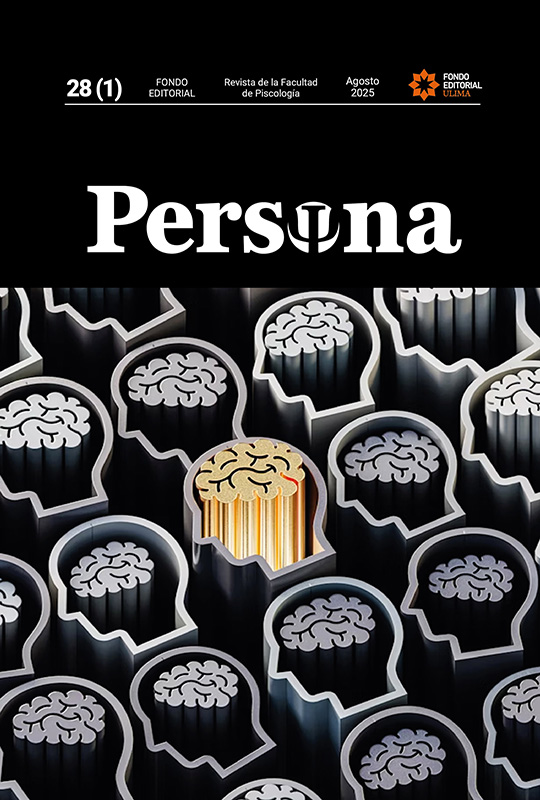Adaptación y validación de la escala de punitivismo al contexto argentino
DOI:
https://doi.org/10.26439/persona2025.n1.7737Palabras clave:
punitivismo, adaptación, validación, necesidad de cierre cognitivoResumen
El punitivismo puede ser definido como la preferencia colectiva por medidas de castigo y aumento de control sobre los criminales. Una comprensión clara del punitivismo en psicología implica comprender las creencias, experiencias y emociones detrás de las decisiones de los individuos. La escala de punitivismo propuesta por Roberts et al. (2011) consiste en siete ítems con formato tipo Likert de cinco puntos; fue diseñada para medir el deseo de los individuos de que se apliquen castigos más severos a quienes cometen delitos. Dicho constructo no se ha abordado en profundidad en psicología y no se ha implementado aún una escala para el mismo en Argentina. Esta investigación tiene como objetivo adaptar y validar la escala de punitivismo de Roberts et al. al contexto argentino. Para ello, se realizó un estudio piloto sobre una muestra de 401 individuos y se realizó un análisis factorial exploratorio. Luego, se realizó un estudio final sobre otra muestra, de 458 participantes, y un análisis factorial confirmatorio. Como resultado, se identificaron inconsistencias en uno de los ítems, por lo que se lo eliminó y se formó una escala unidimensional de seis ítems que obtuvo buenas medidas de ajuste e índices de confiabilidad aceptables. El presente trabajo es un aporte al conocimiento del punitivismo en Argentina y proporciona una escala que permite posteriores investigaciones en dicho contexto.
Descargas
Referencias
Aguilar, J. A. (2018). Aproximación al análisis de las actitudes punitivas. Revista Criminalidad, 60(1), 95-110. https://doi.org/10.47741/17943108.11
Aizpurúa González, E. (2015). Delimitando el punitivismo. Las actitudes de los españoles hacia el castigo de los infractores juveniles y adultos. Revista Española De Investigación Criminológica, 13, 1-30. https://doi.org/10.46381/reic.v13i0.90
Armborst, A. (2017). How fear of crime affects punitive attitudes. European Journal on Criminal Policy and Research, 23, 461-481. https://doi.org/10.1007/s10610-017-9342-5
Asociación Médica Mundial. (2013). Declaración de Helsinki de la AMM – Principios éticos para las investigaciones médicas con participantes humanos. https://www.wma.net/es/policies-post/declaracion-de-helsinki-de-la-amm-principios-eticos-para-las-investigaciones-medicas-en-seres-humanos/
Ballester Esteve, I., Fernández Piqueras, R., & Parra-Camacho, D. (2021). Adaptación y validación de una escala para la evaluación del desempeño profesional del entrenador de fútbol en base a su formación permanente, nivel de TIC y autoevaluación. Retos: Nuevas tendencias en Educación Física, Deportes y Recreación, 40, 272-280.
Bottoms, A. (1995). The philosophy and politics of punishment and sentencing. En C. Clarkson & R. Morgan (Eds.), The politics of sentencing reform (pp. 17-50). Oxford University. https://doi.org/10.1093/oso/9780198258728.003.0002
Carretero-Dios, H., & Pérez, C. (2005). Normas para el desarrollo y revisión de estudios instrumentales. International Journal of Clinical and Health Psychology, 5(3), 521-551. http://www.redalyc.org/articulo.oa?id=33705307
Chen, F. F. (2007). Sensitivity of goodness of fit indexes to lack of measurement invariance. Structural Equation Modeling: A Multidisciplinary Journal, 14(3), 464-504.
Cheung, G. W., & Rensvold, R. B. (2002). Evaluating goodness-of-fit indexes for testing measurement invariance. Structural Equation Modeling, 9(2), 233-255.
Cohen, J. (1988). Statistical power analysis for the behavioral sciences (2.a ed.). Routledge. https://utstat.toronto.edu/brunner/oldclass/378f16/readings/CohenPower.pdf
Costelloe, M. T., Chiricos., T. & Gertz, M. (2009). Punitive attitudes toward criminals: Exploring the relevance of crime salience and economic insecurity. Punishment & Society, 11, 25-49. https://doi.org/10.1177/1462474508098131
Delacre, M., & Klein, O. (2019). Routliers: Robust outliers detection. R package version 0.0.
DeVellis, R. F. (2017). Scale development: Theory and applications (4.a ed.). Sage Publications.
Dominguez Lara, S. (2018). Fiabilidad y alfa ordinal. Actas Urológicas Españolas, 42(2), 140-141. https://doi.org/10.1016/j.acuro.2017.07.002
Elosua, P. (2005). Evaluación progresiva de la invarianza factorial entre las versiones original y adaptada de una escala de autoconcepto. Psicothema, 17(2), 356-362. https://www.psicothema.com/pdf/3112.pdf
Field, A. (2013). Discovering statistics using IBM SPSS Statistics (4.a ed.). Sage Publishing. https://sadbhavnapublications.org/research-enrichment-material/2-Statistical-Books/Discovering-Statistics-Using-IBM-SPSS-Statistics-4th-c2013-Andy-Field.pdf
Garland, D. (2005). La cultura del control. Crimen y orden social en la sociedad contemporánea. Gedisa.
Giacomantonio, M., & Pierro, A. (2014). Individual differences underlying punishment motivation: The role of need for cognitive closure. Social Psychology, 45(6), 449-457. https://doi.org/10.1027/1864-9335/a000211
Giacomantonio, M., Pierro, A., Baldner, C., & Kruglanski, A. (2017). Need for closure, torture, and punishment motivations. Social Psychology, 48(6), 335-347. https://doi.org/10.1027/1864-9335/a000321
Hair, J. F., Ringle, C. M., & Sarstedt, M. (2011). PLS-SEM: Indeed a silver bullet. Journal of Marketing theory and Practice, 19(2), 139-152. https://doi.org/10.2753/MTP1069-6679190202
Hu, L. T., & Bentler, P. M. (1999). Cutoff criteria for fit in-dexes in covariance structure analysis: Conventional criteria versus new alternatives. Structural Equation Modeling: A Multidisciplinary Journal, 6(1), 1-55.
International Test Commission. (2017). The ITC guidelines for translating and adapting tests (2.a ed.). https://www.intestcom.org/files/guideline_test_adaptation_2ed.pdf
Jackson, J., Hough, M., Bradford, B., & Kuha, J. (2015). Empirical legitimacy as two connected psychological states. En G. Meško & J. Tankebe (Eds.), Trust and legitimacy in criminal justice (pp. 137-160). Springer, Cham. https://doi.org/10.1007/978-3-319-09813-5_7
Jaume, L. C., Schetsche, C., Roca, M. A., & Quattrocchi, P. (2022). Factor structure and internal consistency on a reduced version of the revised test of need for cognitive closure. Frontiers in Psychology, 12. https://doi.org/10.3389/fpsyg.2021.813115
Jaume, L. C., & Roca, M. A. (2020). La evaluación del perdón, los modos regulatorios y la necesidad de cierre cognitivo: construyendo una agenda de investigación. Subjetividad y Procesos Cognitivos, 24(1), 1-21. https://publicacionescientificas.uces.edu.ar/index.php/subyprocog/article/view/846/864
Jordan Muiños, F. M. (2021). Valor de corte de los índices de ajuste en el análisis factorial confirmatorio. Psocial, 7(1), 66-71. http://portal.amelica.org/ameli/journal/123/1232225009/
Jorgensen, T. D., Pornprasertmanit, S., Schoemann, A. M., & Rosseel, Y. (2022). semTools: Useful tools for structural equation modeling. R package version 0.5-6. https://cran.r-project.org/package=semTools
Kessler, G. (2011). La extensión del sentimiento de inseguridad en América Latina: Relatos, acciones y políticas en el caso argentino. Revista de Sociologia e Política, 19(40), 83-97. https://doi.org/10.1590/S0104-44782011000300007
Kline, P. (2000). Handbook of psychometric testing (2.a ed.). Routledge.
Kruglanski, A. W. (1989). Lay epistemics and human knowledge: Cognitive and motivational bases. Springer.
Laterzo, I. G. (2023). Progressive ideology and support for punitive crime policy: Evidence from Argentina and Brazil. Comparative Political Studies, 57(6), 1034
Ley 25.326 Protección integral de los datos personales. Octubre 4 del 2000. Arts. 5-7 y 10 (Argentina). Boletín Nacional. https://www.argentina.gob.ar/normativa/nacional/ley-25326-64790
Leys, C., Delacre, M., Mora, Y. L., Lakens, D., & Ley, C. (2019). How to classify, detect, and manage univariate and multivariate outliers, with emphasis on pre-registration. International Review of Social Psychology, 32(1), 1-10.
Lipman, M. (1998). Pensamiento complejo y educación (2.a ed.). Ediciones de la Torre. https://ia903101.us.archive.org/35/items/LipmanPensamientoComplejoYEducacin/Lipman%20-%20pensamiento%20complejo%20y%20educaci%C3%B3n.pdf
Lüdecke, D., Ben-Shachar M., Patil I., & Makowski D. (2020). Extracting, computing and exploring the parameters of statistical models using R. Journal of Open Source Software, 5(53), 2445. https://doi.org/10.21105/joss.02445
Manzano, L., Fredes, D., Carvajal, J., & Cortés, F. (2022). Medición y análisis del punitivismo mediante una encuesta web. Revista de Sociología, 37(1), 147-164.
Mardia, K. V. (1970). Measures of multivariate skewness and kurtosis with applications. Biometrika, 57(3), 519-530.
McDonald, R. P. (1999). Test theory: A unified treatment. Lawrence Erlbaum Associates Publishers. https://psycnet.apa.org/record/1999-02770-000
Otamendi, M. A. (2012). Aclarando el panorama. Punitividad pública en el AMBA (2000-2010). Definiciones y precisiones. Ensemble, 4(7), 1-15 http://hdl.handle.net/11336/200083
Otamendi, M. A. (2020). La punitividad del público como reacción instrumental y expresiva ante las amenazas al comienzo del siglo XXI. Evidencias del Área Metropolitana de Buenos Aires. Revista CS, 31, 77-108. https://doi.org/10.18046/recs.i31.3720
Pierro, A., & Kruglanski, A. W. (2005). Revised Need for Cognitive Closure Scale [Manuscrito inédito]. Università di Roma.
Rader, N. E., Cossman, J. S., & Porter J. R. (2012). Fear of crime and vulnerability: Using a national sample to examine two competing paradigms. Journal of Criminal Justice, 40(2), 134-141. https://doi.org/10.1016/j.jcrimjus.2012.02.003
R Core Team (2023). R: A language and environment for statistical computing (Versión 4.5.1) [Software].
Revelle, W. (2023). psych: Procedures for psychological, psychometric, and personality research. R package version 2.3.9. Recuperado el 23 de junio del 2025, de https://CRAN.R-project.org/package=psych
Roberts, L. D., Spiranovic, C., & Indermaur, D. (2011). A country not divided: A comparison of public punitiveness and confidence in sentencing across Australia. Australian & New Zealand Journal of Criminology, 44(3), 370-386. https://doi.org/10.1177/0004865811419059
Romero, K. P., & Mora, O. M. (2020). Análisis factorial exploratorio mediante el uso de las medidas de adecuación muestral kmo y esfericidad de bartlett para determinar factores principales. Journal of Science and Research, 5, 903-924. https://revistas.utb.edu.ec/index.php/sr/article/view/1046
Rosseel, Y. (2012). lavaan: An R package for structural equation modeling. Journal of Statistical Software, 48(2), 1-36. https://doi.org/10.18637/jss.v048.i02
Rhodes-Purdy, M. (2021). Lock them up! Punitive aggression and populism as political vigilantism. Electoral Studies, 74, Artículo 102415. https://doi.org/10.1016/j.electstud.2021.102415
Shi, L. (2022). Crime trend perceptions, negative emotions, and public punitiveness: A survey experiment of information treatment. Journal of Experimental Criminology, 18, 277-295.
Singer, A. J., Chouhy, C., Lehmann, P. S., Stevens, J. N., & Gertz, M. (2020). Economic anxieties, fear of crime, and punitive attitudes in Latin America. Punishment & Society, 22(2), 181-206. https://doi.org/10.1177/1462474519873659
Silver, J. R., & Ulmer, J. T. (2023). Moral intuitions, punishment ideology, and judicial sentencing. Journal of Crime and Justice, 47(2), 219-240. https://doi.org/10.1080/0735648X.2023.2248085
Smith, G. T., McCarthy, D. M., and Anderson, K. G. (2000). On the sins of short-form development. Psychological Assessment, 12, 102-111. https://doi.org/10.1037/1040-3590.12.1.10
Ugarte Ontiveros, D., & Aparicio de Guzman, R. M. (2020). Técnicas robustas y no robustas para identificar outliers en el análisis de regresión. Investigación & Desarrollo, 20(2), 41-56.
Veggi, S., & Zara, G. (2023). The role of personality and the need for cognitive closure in shaping punitiveness to crime. Personality and Individual Differences, 214, 112348. https://doi.org/10.1016/j.paid.2023.112348
Publicado
Número
Sección
Licencia
La aceptación de publicación implica ceder los derechos de impresión y de reproducción por cualquier forma y medio al editor, manteniendo el autor la propiedad intelectual del artículo.











